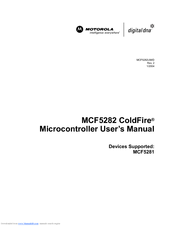Motorola ColdFire MCF5281 Manuals
Manuals and User Guides for Motorola ColdFire MCF5281. We have 1 Motorola ColdFire MCF5281 manual available for free PDF download: User Manual
Motorola ColdFire MCF5281 User Manual (816 pages)
Motorola Microcontroller User's Manual
Brand: Motorola
|
Category: Microcontrollers
|
Size: 9.86 MB
Table of Contents
-
-
Chip Select67
-
UART Modules68
-
Reset70
-
Flexcan71
-
I 2 C Bus71
-
-
-
MAC Opcodes118
-
Chapter 4
125-
Cache Features125
-
Cache Operation127
-
Reset129
-
Cache Registers131
-
-
-
Features143
-
Block Diagram144
-
Memory Map146
-
CFM Registers150
-
CFM Operation159
-
Read Operations159
-
Write Operations159
-
Stop Mode164
-
Master Mode165
-
Back Door Access166
-
Reset166
-
Interrupts167
-
-
-
Features169
-
Memory Map170
-
Low-Power Modes173
-
Wait Mode174
-
Reset Controller178
-
Clock Module179
-
Watchdog Timer180
-
-
-
Overview187
-
Features187
-
SCM Register Map188
-
Overview197
-
Overview200
-
Features200
-
GPACR Register204
-
-
-
Features207
-
Normal PLL Mode207
-
1:1 PLL Mode208
-
Block Diagram209
-
Extal210
-
Xtal211
-
Clkout211
-
Clkmod[1:0]211
-
Rstout211
-
PLL Operation218
-
-
-
Memory Map233
-
-
Introduction247
-
-
Chapter 11
248 -
Chapter 12
257 -
Chapter 13
265-
Features265
-
Bus Cycle States269
-
Read Cycle270
-
Write Cycle272
-
-
Burst Cycles274
-
-
Single-Chip Mode297
-
Chapter 14
297-
-
Test Signals312
-
-
Overview315
-
SDRAM Commands317
-
SDRAM Example333
-
DMR0 Register336
-
-
Overview341
-
-
Chapter 16
342 -
Chapter 17
358-
MII Mode364
-
-
Reception Errors375
-
-
Registers379
-
-
-
Introduction409
-
-
Signals410
-
Block Diagram410
-
-
-
Overview415
-
-
Signals416
-
Features423
-
Gptn[2:0]425
-
Gptn3426
-
Syncn426
-
-
Prescaler439
-
-
Input Capture439
-
Output Compare439
-
-
Reset443
-
Interrupts443
-
-
Overview447
-
-
Prescaler448
-
-
Capture Mode449
-
Output Mode449
-
-
Chapter 22
458-
-
Operation459
-
-
Qspi Ram460
-
-
QSPI RAM Model461
-
Transfer Delays463
-
-
Transfer Length464
-
-
Data Transfer464
-
QSPI Registers465
-
QSPI Timing472
-
Overview475
-
-
Receiver Timing497
-
Looping Modes499
-
-
Automatic Echo499
-
Local Loop-Back499
-
Multidrop Mode500
-
-
Remote Loop-Back500
-
-
Bus Operation502
-
-
Programming502
-
UART Interrupts503
-
-
Overview511
-
Repeated START514
-
Handshaking515
-
Clock Stretching515
-
-
Slave Mode523
-
Arbitration Lost524
-
Features527
-
-
-
The CAN System530
-
-
Receive Process535
-
Transmit Process535
-
Remote Frames538
-
Listen-Only Mode539
-
Overload Frames539
-
Time Stamp539
-
Bit Timing540
-
Introduction559
-
Overview561
-
-
Chapter 31
561 -
Chapter 26
564-
-
Overview583
-
Features585
-
-
Debug Mode587
-
Stop Mode587
-
-
Chapter 27
588-
Signals588
-
QADC Memory Map592
-
-
Status Registers603
-
-
Queue Status608
-
-
Result Registers613
-
-
Trigger Events624
-
Status Bits624
-
-
Scan Modes634
-
Disabled Mode634
-
Reserved Mode634
-
-
Interrupts659
-
Features661
-
Chapter 19
662-
Signals662
-
-
Reset Sources666
-
-
-
Software Reset667
-
-
Overview673
-
CLKOUT Timing674
-
-
Chapter 28 RSTI
662-
Block Diagram662
-
-
Chapter 29
676-
-
CPU Halt688
-
-
Features719
-
Master Mode720
-
Chapter 30
720-
Single-Chip Mode720
-
Rcon721
-
-
Memory Map722
-
-
Reset730
-
Interrupts730
-
-
IDCODE Register735
-
-
JTAG Module737
-
-
TAP Controller737
-
-
Chapter 33
751-
Maximum Ratings751
-
SDRAM Read Cycle766
-
SDRAM Timing766
-
GPIO Timing768
-
QSPI Timing774
-
TRST Timing776
-
BKPT Timing777
-
Advertisement
